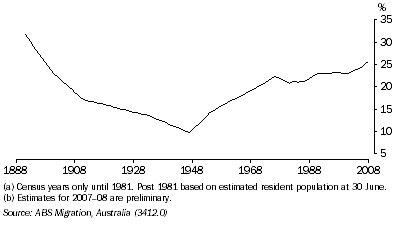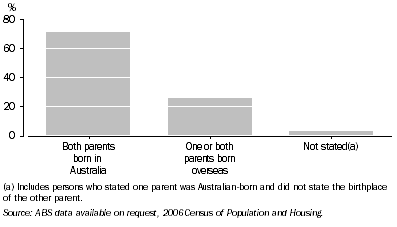COUNTRY OF BIRTH
Australia's population has increased each year since the end of World War II, due to a combination of high post-war fertility and high levels of migration. In 1901, 23% of Australia's population was born overseas. By 1947, the proportion of the overseas-born population had declined to 10%. The creation of a national government immigration portfolio in 1945 accompanied a gradual increase in the proportion of overseas-born Australians, reaching 22% by 1977. During the 1980s, 1990s and the early 2000s the overseas-born population fluctuated between 21% and 23%. At 30 June 2008, the number of overseas-born Australians was 5.5 million, representing just over one-quarter (26%) of the total population (graph 7.32).
7.32 AUSTRALIA'S POPULATION BORN OVERSEAS(a)(b)

The past 25-30 years have seen patterns of immigration change and the diversity of countries of birth increase. Of the overseas-born population, the United Kingdom remains the largest source country, despite having fallen from 34% of the overseas-born population in 1981 to 21% in 2008. Some of the older migrant streams, such as people born in Italy and Greece, have declined in absolute numbers as their populations aged and the number of deaths exceeded net gains in population from more recent migration.
In contrast, over the same time frame, the New Zealand-born population living in Australia nearly trebled, and in 2008 was the second largest overseas-born group making up 9% of the overseas-born population. Some other migrant streams that have increased their proportion over recent decades include those born in China, India, the Philippines, South Africa, and Malaysia (see table 7.33). For example, the China-born population increased twelve fold, from 25,200 people in 1981 to 313,600 people in 2008 (making up 6% of the overseas-born population from 1% in 1981). The India-born population increased its share from 1% in 1981 (41,000 people) to 4% in 2008 (239,300 people).
7.33 Main Countries of Birth(a) |
|
 | 1954(b) | 1961(b) | 1971(b) | 1981(b) | 1996(c) | 2001(c) | 2006(c) | 2008(c) |
 | '000 | '000 | '000 | '000 | '000 | '000 | '000 | '000 |
|
| United Kingdom(d) | 664.2 | 755.4 | 1 081.3 | 1 075.8 | 1 164.1 | 1 126.9 | 1 153.3 | 1 166.5 |
| New Zealand | 43.4 | 47.0 | 74.1 | 160.7 | 315.1 | 394.1 | 476.7 | 494.6 |
| China(e) | 10.3 | 14.5 | 17.1 | 25.2 | 121.1 | 157.0 | 203.1 | 313.6 |
| India | 12.0 | 14.2 | 28.7 | 41.0 | 84.8 | 103.6 | 153.6 | 239.3 |
| Italy | 119.9 | 228.3 | 288.3 | 275.0 | 259.1 | 238.5 | 220.5 | 221.7 |
| Vietnam | na | na | na | 40.7 | 164.2 | 169.5 | 180.4 | 193.3 |
| Philippines | 0.2 | 0.4 | 2.3 | 14.8 | 102.7 | 112.2 | 135.6 | 155.1 |
| South Africa | 6.0 | 7.9 | 12.2 | 26.5 | 61.7 | 86.9 | 118.8 | 136.2 |
| Greece | 25.9 | 77.3 | 159.0 | 145.8 | 141.8 | 132.5 | 125.8 | 130.5 |
| Germany | 65.4 | 109.3 | 110.0 | 109.3 | 120.8 | 117.5 | 114.9 | 126.5 |
| Malaysia | 2.3 | 5.8 | 14.4 | 30.5 | 83.0 | 87.2 | 103.9 | 120.1 |
| Netherlands | 52.0 | 102.1 | 98.6 | 95.1 | 95.3 | 91.2 | 87.0 | 90.3 |
| Lebanon | 3.9 | 7.3 | 23.9 | 49.4 | 77.6 | 80.0 | 86.6 | 89.1 |
| Hong Kong (SAR of China) | 1.6 | 3.5 | 5.4 | 15.3 | 77.1 | 75.2 | 76.3 | 87.5 |
| Total overseas-born | 1 285.8 | 1 778.3 | 2 545.9 | 2 950.9 | 4 258.6 | 4 482.1 | 4 956.9 | 5 485.9 |
| Australian-born | 7 700.1 | 8 729.4 | 10 173.1 | 11 388.8 | 14 052.1 | 14 931.2 | 15 648.6 | 15 945.9 |
| Total population(f) | 8 986.5 | 10 508.2 | 12 719.5 | 14 516.9 | 18 310.7 | 19 413.2 | 20 605.5 | 21 431.8 |
|
| na not available |
| (a) Country selection based on population at 30 June 2008. |
| (b) Census counts. |
| (c) Estimated resident population at 30 June. |
| (d) Includes Ireland in 1954, 1961 and 1971. |
| (e) Excludes SARs and Taiwan Province. |
| (f) Includes country of birth ‘Not stated’ and ‘At sea’. |
| Source: ABS Migration, Australia (3412.0). |
The 2006 Census data show that 26% of people born in Australia had at least one overseas-born parent. Of these, 44% had both parents born overseas, 34% had their father (but not their mother) born overseas and 23% had their mother (but not their father) born overseas (graph 7.34).
7.34 BIRTHPLACE OF PARENTS OF AUSTRALIAN-BORN PEOPLE - 2006

 Print Page
Print Page